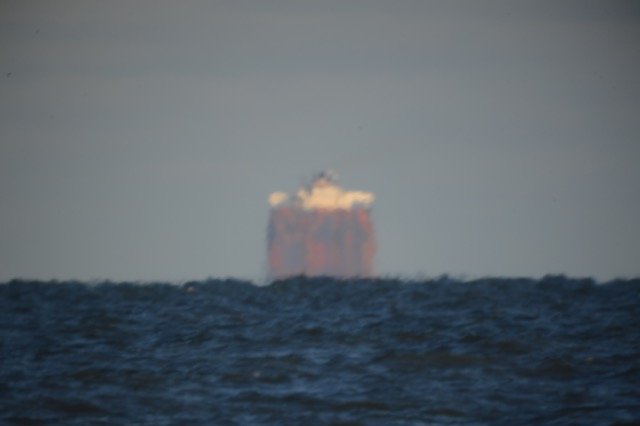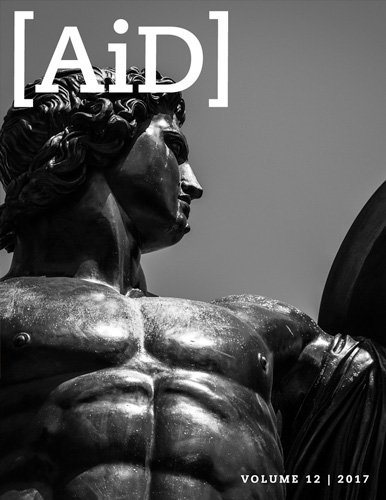
Flat Earth Proof—Just a Mirage
The flat earth movement began in the 19th century with the publications of Samuel Rowbotham. In the summer of 1838, Rowbotham conducted his Bedford level experiment. The Bedford level is a six-mile stretch of water that is very straight and level. Over the six miles, the earth ought to curve downward by 24 feet. Rowbotham stationed himself at one end of the Bedford level, and arranged for someone else in a small boat to row to the other end. A five-foot mast was attached to the boat, so certainly by the end of the level the mast would not be visible, because the top of the mast would have been 11 feet below Rowbotham’s line of sight. Rowbotham observed the boat with a telescope mounted eight inches above the water. Rowbotham could see the small boat over the entire course of the Bedford level, whereupon he became convinced that the earth was flat. I’ve previously discussed the Bedford level experiment, in which I explained that atmospheric refraction bent the light of the boat along the surface of the earth, making the boat visible, even though the boat actually was below the direct line of sight. Here I wish to expand upon the phenomenon that caused Rowbotham’s experiment to go awry.
Rowbotham was a victim of a superior mirage. When flat-earthers hear this, they normally respond by dismissing this as impossible, because mirages supposedly are inverted images, but Rowbotham saw the boat right side up the entire time. However, this confuses superior and inferior mirages. What is the difference? First we must discuss the physics of light a bit.
Total Internal Reflection
Light travels at a finite speed, with the speed depending upon the medium. With mirages, the medium is air. In air, the speed of light is only slightly less than it is in a vacuum, and the speed of light in air depends upon the temperature of the air. Simply put, the speed of light is slightly greater in warmer air than it is in cooler air. In physics, we usually express this behavior reciprocally as the index of refraction, n:
n = c/v,
where c is the speed of light in a vacuum, and v is the speed of light in any medium, in this case, air. Since the speed of light is greater in warmer air, warmer air has a lower index of refraction than cooler air. More specifically, the speed of light also depends upon air pressure, or expressing this conventionally as the index of refraction:
n(P,T) = 1 + 0.000293 (P/P0)(T0/T),
where P and T are the pressure and temperature of air, and P0 and T0 are the standard values of one atmosphere of pressure and 300K. Since with mirages there is no appreciable height difference, pressure differences are negligible, and so the temperature difference dominates differences in the index of refraction. When light travels from one medium to another, the path of the light is refracted, or bent. This is what causes the “bent stick” appearance of a long object partially inserted in water, such as a pole placed into the water of a pool. This behavior is described by Snell’s law:
sin θ1/ sin θ2 = n2/n1,
where θ1 and θ2 are the angles that the light rays make with the perpendicular to the interface between the two media, and n1 and n2 are the indices of refraction of the two media (see Figure 1). Depending upon which direction the light is traveling, one of the angles is the angle of incidence, and the other angle is the angle of refraction.

Figure 1
For most media and angles of incidence, the light transmits from one medium to the other. However, when passing from a medium of higher index of refraction into a medium of lower index of refraction at a sufficiently high angle of incidence, there may not be a real value for the angle of refraction. When this happens, the light cannot pass into the second medium. Instead, the light is reflected off the interface and back into the first medium. We call this phenomenon total internal reflection. Many devices make use of total internal reflection. Total internal reflection allows a prism with two 45-degree angles and one 90-degree angle to reflect light at a right angle. One could use a mirror mounted at a 45-degree angle to do the same thing, but total internal reflection is nearly 100% efficient, while the best mirrors are perhaps 85% efficient. Many optical devices, such as binoculars and periscopes, make use of this. Fiber optics are thin wires of glass. Being so thin, fiber optics are flexible and as easy to handle as any metal wire. Glass has a relatively high index of refraction, so light shining down a fiber optic is totally reflected internally by the walls of the fiber optic, if the fiber optic is not bent too sharply. We use fiber optics every day with telephone, cable TV, and internet connections.
What must be the angle of incidence for total internal reflection to occur? Let medium 1 be the medium with the higher index of refraction. As θ1 increases, θ2 also increases, albeit at a faster rate. When θ2 reaches 90 degrees, there is total internal reflection, and there is no transmission of light. The corresponding angle of incidence, θ1, is the critical angle where total internal reflection occurs. Let the critical angle be θc. Substituting into Snell’s law:
sin θc = n2/n1
From the second equation above, the index of refraction at one atmosphere of pressure and a temperature of 310 K (50 degrees F) is 1.000284, while the index of refraction at one atmosphere of pressure and a temperature of 320 K (68 degrees F) is 1.000275. These values yield a critical angle of 89.76 degrees. Hence, when air attempts to pass from 310 K to 320 K air at one atmosphere of pressure, the light will be totally internally reflected if the angle of incidence is greater than 89.76 degrees, or less than about a quarter of a degree from grazing incidence. If the temperature difference is greater, the critical angle will be less; hence the angle from grazing incidence will be greater.
Inferior Mirages
Inferior mirages are the most commonly noticed type of mirage; therefore, in the minds of most people, it is the only type of mirage. An inferior mirage occurs when there is a layer of warm air in contact with the ground, with layers of much cooler air just above. This condition exists nearly every sunny day. As the sun’s radiation is absorbed by the ground, the air in contact with the ground heats. Air a short distance above the ground remains cooler, so a large temperature difference can exist between these two layers. Because this temperature difference is most pronounced when the sun is as high in the sky as possible, this condition is most likely to occur in the early afternoon in late spring and into summer. The type of surface exposed to sunlight is very important too, because dark, flat surfaces, such as pavement, rock, and sand are most efficient at heating air this way. Surfaces with much vegetation, such as grass, are far less efficient in doing this. Because of its high specific heat and great optical depth, water generally is very poor at producing conditions conducive to an inferior mirage. The above example of a 10-degree difference in air temperature is rather modest—much greater temperature differences occur under ideal conditions of early summer, decreasing the critical angle, and increasing the angle above grazing where an inferior mirage can happen.
With these conditions, light from a distant object near but above the horizon reflects off the warmer air (see Figure 2).

Figure 2
One of the most common objects reflected in this way is blue sky, which our brains interpret as light reflecting off a body of water. The reflected image appears below the object, which is why we call this an inferior mirage. The layer of warm air near the surface acts much like an ordinary mirror. As a mirror reverses direction left to right, an inferior mirage reverses direction from top to bottom (you see the same thing with a mirror if you tilt your head 90 degrees and look at reflections in the mirror.) The reversal happens because light from the top of a distant object will reflect closer to the observer than light from the bottom of the object. Therefore, inferior mirages usually appear inverted. Early in the morning or late in the afternoon, solar heating of the ground is not nearly as great, so inferior mirages are less likely to happen then. The same is true during autumn and winter when the sun is much lower in the sky.
The warm surface air that causes inferior mirages tends to expand. As air expands, it becomes less dense, producing buoyancy. Buoyant force causes the warm air to rise, and the air must be replaced somehow. This unstable condition leads to upward and downward motion of air (turbulence). Light passing through turbulent air is blurred. The constantly changing turbulence causes the images to shimmer. It is unusual for an inferior mirage to be steady.
Superior Mirages
As previously mentioned, the reaction of bodies of water with sunlight is very different from that of land. Being largely transparent, light penetrates deeply into water, so that the sun’s light is absorbed throughout a thick layer from the surface to some depth rather than just on the surface, as with land. Additionally, water has a high specific heat, which means that its temperature increases very slowly as heat is added. Consequently, water exposed to sunlight does not change temperature appreciably throughout the day, so there is no heating of air in contact with the water. If anything, during summer afternoons, when land is rapidly heating, bodies of water frequently are cooler than air temperature. The cooler water chills the air in direct contact with it, so the air lying just above water often is cooler than air higher up. Since air temperature normally decreases with height, this temperature reversal from the norm is called a temperature inversion. Temperature inversions are common over bodies of water during late spring and into summer. Since this temperature structure is the reverse of what causes inferior mirages, inferior mirages are far less commonly noticed over water. This happens particularly during the summer, when inferior mirages are common over land.
Consider light from a distant object that is emitted horizontally, parallel to the water’s surface at the location of the object (see Figure 3).

Figure 3
With increasing distance from the object, the earth’s curvature causes the surface of the water to fall away from the beam of light. Over one mile, the amount of drop is eight inches, but the drop increases quadratically with distance. Consequently, after three miles the drop is six feet, and after six miles the drop is 24 feet. This is the point of the Bedford level experiment—the curvature of the earth ought to intervene to prevent the mast of the boat being visible from much more than three miles, let alone six miles. However, for the light from the distant object not to be visible, it would have to travel in a straight line. But with a temperature inversion, straight-line motion would carry the light from a cooler layer of air into a warmer layer of air at nearly a grazing angle. The light cannot do this, so it continually is internally reflected, causing the light to bend around the edge of the earth. Therefore, with a temperature inversion, one can see objects that lie well beyond the edge of the earth’s curvature when viewing close to the surface of water.
Since this image is visible above where the object is, it is called a superior mirage. Because cooler air has no physical reason to rise, a temperature inversion is a stable situation, with little convection as with the condition that produces an inferior mirage. Therefore, superior mirages can be very steady, much steadier than inferior mirages. Furthermore, since the refraction acts almost continually rather than at one point, superior mirages normally are erect rather than inverted. If one gains a little altitude, one can get out of the inversion layer, and thus avoid seeing a superior mirage. In my earlier article, I pointed out that this is what Alfred Russell Wallace did when he repeated the Bedford level experiment. Russell did not see the distant object that was his target, which is consistent with a spherical earth. Russell correctly accounted for this effect, but Rowbotham did not.
My Own Experiment
Since temperature inversions are common over water, it is relatively easy to devise experiments in which distant objects beyond the curvature of the earth are visible. Perhaps the most famous are the photographs of the Chicago skyline taken across Lake Michigan, about 60 miles away. The photographer, Joshua Nowicki, does not promote the flat earth, but flat-earthers have used his photographs many times, such as here, as supposed proof that the earth is flat. Flat-earthers do not seem to be aware of just how rare these photographs are. If the earth were flat, then the Chicago skyline would be visible across Lake Michigan nearly every clear day, but it is not. If the earth is spherical, then the hulls of ships ought to disappear as the ships move away from the observer. Since the ship must move many miles away for this to become noticeable, it is difficult to see this with the naked eye.
As with the Chicago skyline, there are many images on the internet, usually videos, of ships some distance away in which their hulls are visible. Many of these are taken during warm weather, such as late spring and summer, when the water is likely to be much cooler than the air, producing a temperature inversion. However, what would happen if one were to repeat this experiment over water that is warmer than the air temperature? Since there is no temperature inversion, the hulls of ships ought to disappear. This condition is likely to prevail on cool days in late autumn and early winter, when water temperatures are higher than air temperatures. These conditions also can produce inferior mirages, though not nearly as pronounced as over land on sunny summer days.
On November 12, 2016, I had the opportunity to conduct this experiment. I was near the water’s edge, just beyond the surf, at Virginia Beach from middle to late afternoon. When I began, the air temperature was 50 degrees F, and the temperature dropped a degree or two by the time that I was done, near sunset. The water temperature was 62–64 degrees F, so the air immediately above the water was at least ten degrees warmer than the air temperature a short distance above the water. I photographed two cargo ships as they made their way out to sea from the port at Hampton Roads. I mounted a digital SLR camera on a 3.5-inch Questar telescope, having a 1,200-mm focal length. The ISO setting on the camera was 100 for all photographs.
The first photograph (Figure 4) is of a cargo ship bearing the name of the company on its hull. The company is the NYK line, a major Japanese shipping company. Notice that the bottoms of the letters are not visible. The letters on the hulls of cargo ships do not extend to the water line, even when fully loaded, so clearly the bottom of the hull is not visible. This is consistent with what we would expect on a spherical earth, but not on a flat earth. Notice the white bridge castle to the left. The shipping containers are multicolored, and they are stacked at least seven high above the hull directly in front of the bridge castle. Below the visible tiers of the multi-colored containers there is a level of what appears to be gray containers. It is not clear why the containers in this layer are the same color. Finally, notice that the image is a bit blurry. This is because of turbulence in the air between the ship and shore. With increasing distance, the turbulence will get worse, and the images will get blurrier.

Figure 4
In the next photograph and succeeding photographs, the ship is farther away, as indicated by the decreasing apparent size of the ship. In Figure 5, an inferior mirage is starting to show up. At the edge of the water, you can see a gray line, which is an inferior mirage of the row of gray containers right above the hull. On the right side of the ship, you can see the inferior mirage of the bow. The hull protrudes forward there, and the small white patch just above is a small portion of the forecastle. Notice that the inferior mirage of the bow is inverted, as one would expect. It is difficult to see here, but the lettering on the hull also is undergoing an inferior mirage too.

Figure 5
In the next photograph (Figure 6), the lettering on the hull is no longer visible. The layer of gray containers is even more visible in the inferior mirage, and the first layer of multi-colored containers is now beginning to appear in the inferior mirage. In the next photograph (Figure 7), the light from the gray layer of containers and its inferior mirage are beginning to merge. The first layer of the multi-colored containers above it is clearly visible in the inferior mirage. The white of the bridge castle is starting to show up in the inferior mirage. In Figure 8, the layer of gray containers no longer is visible. The bottom of the bridge castle and its inferior mirage have merged. None of the hull is visible. In the next photograph (Figure 9), the ship has turned, so we see the back of the bridge castle and containers on the stern. Much of the bottom of what appears to be the ship is an inferior mirage of the upper containers. At any rate, the hull is clearly not visible. Finally, in Figure 10 none of the containers are visible. All that we can see is the back of the bridge castle, merged with the upside-down inferior mirage. Notice the symmetry between the two.

Figure 6

Figure 7

Figure 8

Figure 9

Figure 10
Another container ship made its way outward, as shown in Figure 11, a photograph taken through the supports of the pier at Virginia Beach. You can clearly read the name of the shipping company, Maersk Line, on the turquoise hull. What appears to be stains under the letters are the beginnings of an inferior mirage of the letters. Instead of a level of gray containers immediately above the hull, the layer of containers right above the hull on this ship appear a deep red. As with the other ship, in each succeeding photograph this ship is farther away, as evidenced by the decreasing apparent sizes of the containers and the ship.

Figure 11
In Figure 12, the ship now appears beyond the pier. Notice that the inferior mirage of the lettering on the hull is much more obvious now. In Figure 13, the lettering and its inferior mirage have not merged. In Figure 14, the lettering is difficult to see. This probably is because most of the lettering is below the horizon, and what appears to be the bottom of the hull is an inferior mirage of the top of the hull. This is clearly seen by the inferior mirage of the first layer of red containers below the turquoise. In Figure 15, the inferior mirage of the bottom layer of containers is more obvious, and the inferior mirage of the bottom of the bridge castle is beginning to show up. Clearly, at least half of the turquoise visible here is an inferior mirage. Most of the hull is below the curvature of the earth. Unfortunately, at this point the sun was about to set, so light levels were dropping quickly, forcing me to use longer exposures. At that point, I stopped taking photographs.

Figure 12

Figure 13

Figure 14

Figure 15
Conclusion
These photographs clearly reveal that the hulls of these two ships progressively disappeared as the ships moved farther away. This is consistent with what we would expect if the earth is spherical, but this cannot be explained if the earth is flat. Therefore, this is good evidence that the earth is spherical. The results presented here contradict the many photos on the internet of objects beyond the horizon that supposedly prove that the earth is flat. Those alleged proofs are flawed because they failed to take account of atmospheric refraction due to a temperature inversion. By conducting this experiment when there was no possibility of a temperature inversion, I avoided that complication. The fact that inferior mirages consistently showed up in the photographs prove that there was no temperature inversion, indicating instead that there was a slightly warmer layer of air in contact with the water, with slightly cooler air above.
Recommended Resources

Answers in Genesis is an apologetics ministry, dedicated to helping Christians defend their faith and proclaim the good news of Jesus Christ.
- Customer Service 800.778.3390
- © 2024 Answers in Genesis





